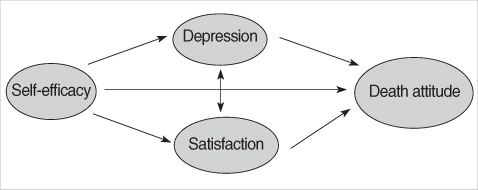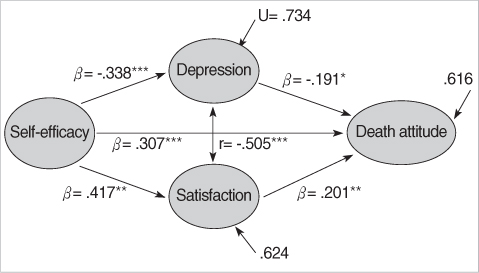Articles
- Page Path
- HOME > J Korean Acad Nurs > Volume 38(2); 2008 > Article
-
Original Article
- Relationship between Self-efficacy, Depression, Level of Satisfaction and Death Attitude of College Students
- Kae-Hwa Jo, Hyun Ji Lee
-
Journal of Korean Academy of Nursing 2008;38(2):229-237.
DOI: https://doi.org/10.4040/jkan.2008.38.2.229
Published online: April 30, 2008
1Associate Professor, Department of Nursing, Catholic University of Daegu, Daegu, Korea.
2Assistant Professor, Department of Social Welfare, Catholic University of Daegu, Daegu, Korea.
- Address reprint requests to: Jo, Kae Hwa. Department of Nursing, School of Medicine, Catholic University of Daegu, 3056-6 Daemyung 4-dong, Nam-gu, Daegu 705-718, Korea. Tel: 82-53-650-4825, Fax: 82-53-621-4106, jokw@cu.ac.kr
Copyright © 2008 Korean Society of Nursing Science
Abstract
-
Purpose
- The purpose of this study was to identify the relationship among self-efficacy, depression, life satisfaction and death attitude of college students.
-
Methods
- The subjects consisted of 232 college students. Data were collected by self-reported questionnaires, which were constructed to include self-efficacy, depression, satisfaction with life, and death attitude. Data were analyzed by the SPSS/PC WIN. 12.0 program.
-
Results
- Death attitude and life satisfaction of college students were significantly different according to frequency of death ideation. Death attitude for college students correlated with self-efficacy, depression, and life atisfaction. The most significant predictor of death attitude for college students was life satisfaction.
-
Conclusion
- The above findings indicate that death attitude for college students is influenced by self-efficacy, depression, and life satisfaction. These findings suggest that a death education program to improve life satisfaction and to give a positive attitude toward death is needed for college students.
- 1. American Psychiatric Association. Diagnostic and statistical manual of mental disorders. 1994;4th ed. Washington, D.C., American Psychiatric Association.
- 2. Bandura A. Self-efficacy: Toward a unifying theory of behavioral change. Psychological Review. 1997;84:191–215.Article
- 3. Bohrnstedt G, Knoke D. Statistics for social dat analysis. 1994;3th ed.Itasca, IL, F. E. Peacock Publishers.
- 4. Burns JM, Andrews G, Szabo M. Depression in young people: what causes it and can we prevent it? The Medical Journal of Australia. 2002;177:S93–S96.PubMed
- 5. Cervone D, Kopp DA, Shauman L, Scott WD. Mood, self-efficacy and performance standards: Lower moods induced higher standards for performance. Journal of Personality and Social Psychology. 1994;67:499–512.Article
- 6. Chan KL, Tiwari A, Leung WC, Ho HW, Cerulli C. Common correlates of suicidal ideation and physical assult among male and female university students in Hong Kong. Violence and Victims. 2007;22:290–303.PubMed
- 7. Chung SK. A relational study on attitudes toward death between life satisfaction and values of juveniles. 1992;Seoul, Ewha Womens University. Unpublished master's thesis.
- 8. Collett LJ, Lester D. The fear of death and the fear of dying. The Journal of Psychology. 1969;72:179–181.ArticlePubMed
- 9. Cooper J, Barnett M. Aspects of caring for dying patients which cause anxiety to first year student nurses. International Journal of Palliative Nursing. 2005;11:423–430.ArticlePubMed
- 10. Diener E. Subjective well-being. The science of happiness and a proposal for a national index. The American Psychologist. 2000;55:34–43.ArticlePubMed
- 11. Donald M, Dower J., Correa-Velez I, Jones M. Risk and protective factors for medically serious suicide attempts: a comparison of hospital-based with population-based samples of young adults. The Australian and New Zealand Journal of Psychiatry. 2006;40:87–96.ArticlePubMedPDF
- 12. Hahn DW, Chon KK, Tak JK, Lee CH, Lee KH. A study on life maladjustment of college students: Based on anxiety, depression and somatization. Paper presented at the meeting of Korean Psychological Association. 1992.
- 13. Hegel MT, Dietrich AJ, Seville JL, Jordan CB. Training residents in problem-solving treatment of depression: a pilot feasibility and impact study. Family Medicine. 2004;36:204–208.PubMed
- 14. Hong HY. The relationships of perfectionism, self-efficacy and depression. 1995;Seoul, Ewha Womens University. Unpublished master's thesis.
- 15. Hong YL, Yi GE, Park HS. A structural model for health promotion and life satisfaction of college students in Korea. Journal of Korean Academy of Community Health Nursing. 2000;11:333–346.
- 16. Jacobs D. Suicide understanding and repondin. 1991;Madison, International University Press.
- 17. Jo KH, Lee HJ, Lee YJ. Types of students'death attitudes majoring in human service area: Q-Methodological approach. Journal of Korean Academy of Nursing. 2005;35:829–841.ArticlePubMedPDF
- 18. Kao SF, Lusk B. Attitudes of Asian and American graduate nursing students towards death and dying. International Journal of Nursing Studies. 1997;34:438–443.ArticlePubMed
- 19. Kim KH. Depression and suicide in Korean adolescents. Korean Journal of Psychological and Social Issues. 2004;10:55–68.
- 20. Kim MA, Lim SH. A Q-study on death among nursing students. Keimyung Journal of Nursing Science. 2002;6:43–54.
- 21. Kim MS, Lim JY. The structure of good life and the relationship with subjective well-being among college students: focusing on gender difference. The Korean Journal of Woman Psychology. 2003;8:83–97.
- 22. Lee HJ, Kim MH. A path model for self-identity and hopelessness to suicidal ideation of college students. Korea Journal of Youth Studies. 2007;14:243–264.
- 23. Lee JH. Depressive symptoms in acute and chronic schizophrenic patients. Unpublished doctoral dissertation. 1994;Seoul, Chung Ang University. Unpublished doctoral dissertation.
- 24. Lee KH, Kim HS, Na C, Kwon HJ, Kim SH, Min BK. A study on the death awareness among health care personnels. The Official Journal of Research Institute of Medical Science of Korea. 1983;15:174–186.
- 25. Makaremi A. Self-efficacy and depression among Iranian college students. Psychological Reports. 2000;86:386–388.ArticlePubMedPDF
- 26. Park HS, Kwon BS. Satisfaction with life and its predictors of college students. Journal of Korean Academy of Psychiatry and Mental Health Nursing. 2006;15:48–56.
- 27. Pyon BK, Kang SK. A study of adolescents' self-esteem and hostility. Korean Journal of Youth Studies. 2002;9:269–291.
- 28. Son MJ. The mechanism and the effectiveness of emotional imagery. 1984;Seoul, Korea University. Unpublished doctoral dissertation.
- 29. Vealey RS. Conceptualization of sport-confidence and competitive orientation: Preliminary investigation and instrument development. Journal of Sport Psychology. 1986;8:221–246.Article
- 30. Zung WW, Richards CB, Short MJ. Self-rating depression scale in an outpatient clinic. Futher validation of the SDS. Archives of General Psychiatry. 1965;13:508–515.PubMed
REFERENCES
Figure & Data
REFERENCES
Citations

- Death education, communication, and happiness: An unlikely general education triad?
Kurt Wise, Laura Bruns
Policy Futures in Education.2025; 23(5): 880. CrossRef - Death attitudes and good life experience: the mediation and suppression effects of intrinsic and extrinsic goals
Yuanyuan Wang, Fuhua Pei, Yisheng Yang, Junxiu Wang
Frontiers in Psychiatry.2025;[Epub] CrossRef - Exploring the impact of a life education program on the resilience of nursing students
Yao-Mei Chuang, Wei-Hsiang Huang, Mostafa Shaban
PLOS One.2025; 20(4): e0322793. CrossRef - Factors influencing the attitude toward death in college nursing student
Jong Gun Kim, Su Min Oh, Eui Young Cheon, Jang Hak Yoo
Journal of the Korea Academia-Industrial cooperation Society.2016; 17(1): 676. CrossRef - Convergence Analysis of Factors Influencing the End-of-life Care Attitude in Undergraduate Nursing Students
Seung Ae Yang
Journal of the Korea Convergence Society.2016; 7(4): 141. CrossRef - Development and Evaluation of Death Education Program for Nursing Students*
Soon-Hee Kim, Dong-Hee Kim
Journal of Korean Academy of Fundamentals of Nursing.2015; 22(3): 277. CrossRef - Types of Attitudes of Nursing Students in Korea Toward Bucket Lists Q-Methodological Approach
Hong Seon Lee, Kae Hwa Jo, Hyun Ji Lee
The Journal of Korean Academic Society of Nursing Education.2015; 21(1): 129. CrossRef - Influence of Appearance Stress, Ego-Resilience, Interpersonal Relations and Depression on Eating Attitude in Women Undergraduates
Hae Kyung Chang, Jung Nam Sohn
Journal of Korean Academy of Fundamentals of Nursing.2014; 21(3): 235. CrossRef - Effects of Perceived Death and Self-esteem on Meaning in Life among University Students
Chun-Gill Kim
Journal of Korean Public Health Nursing.2013; 27(3): 539. CrossRef - Factors Affecting Depression of Korean Female University Students
Kyung-Sook Lee, Chin-Kang Koh, Joo Hyun Kim, Haeng-Mi Son, Mi Ryeong Song, Su Jeong Yu, Kyung Sook Cho
Journal of muscle and joint health.2013; 20(2): 112. CrossRef - Relationship of Psychological Separation, Depression and Antidepressive Coping Behaviors in University Students
Hae-Ok Jeon
Journal of the Korea Academia-Industrial cooperation Society.2012; 13(6): 2655. CrossRef - A comparative study on the spiritual needs between nursing students and nurses in Busan and Gyeongnam province
Hyun Cho, Eun-Kyung Sim, Young-Chae Kwon, Young-Hee Bae, Young-Ok Woo, Jae-Hoon Ji, Ja-Young Jung
Journal of the Korea Academia-Industrial cooperation Society.2012; 13(5): 2178. CrossRef - Comparison of Attitudes of Nursing Students toward Death, Self-esteem and Life Satisfaction according to Clinical Experience
Soon Hee Kim, Dong-Hee Kim, Hyun-Mi Son
The Korean Journal of Hospice and Palliative Care.2011; 14(3): 144. CrossRef - Effects of a Death Education Program on Life Satisfaction and Attitude toward Death in College Students
Eun Hee Kim, Eunjoo Lee
Journal of Korean Academy of Nursing.2009; 39(1): 1. CrossRef


Figure 1
Figure 2
Difference of Death Attitude, Satisfaction, and Depression by Death Thought (N=232)
**p<.01; ***p<.001. Duncan test: a<b.
Correlation matrix of variables (N=232)
*p<.05; **p<.01; ***p<.001.
Multiple Regression of Depression, Satisfaction, and Death Attitude (N=232)
*p<.05; **p<.01; ***p<.001. U, V, W=residual factors.
Direct, Indirect and Total Effects of self-efficacy on Death Attitude (N=232)
**p<.01; ***p<.001. Duncan test: a<b.
*p<.05; **p<.01; ***p<.001.
*p<.05; **p<.01; ***p<.001. U, V, W=residual factors.
 KSNS
KSNS
 E-SUBMISSION
E-SUBMISSION






 Cite
Cite

